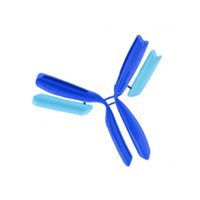Function and expression of ryanodine receptors and inositol 1,4,5-trisphosphate receptors in smooth muscle cells of murine feed arteries and arterioles.
Westcott, EB; Goodwin, EL; Segal, SS; Jackson, WF
The Journal of physiology
590
1849-69
2012
Show Abstract
We tested the hypothesis that vasomotor control is differentially regulated between feed arteries and downstream arterioles from the cremaster muscle of C57BL/6 mice. In isolated pressurized arteries, confocal Ca(2+) imaging of smooth muscle cells (SMCs) revealed Ca(2+) sparks and Ca(2+) waves. Ryanodine receptor (RyR) antagonists (ryanodine and tetracaine) inhibited both sparks and waves but increased global Ca(2+) and myogenic tone. In arterioles, SMCs exhibited only Ca(2+) waves that were insensitive to ryanodine or tetracaine. Pharmacological interventions indicated that RyRs are functionally coupled to large-conductance, Ca(2+)-activated K(+) channels (BK(Ca)) in SMCs of arteries, whereas BK(Ca) appear functionally coupled to voltage-gated Ca2+ channels in SMCs of arterioles. Inositol 1,4,5-trisphosphate receptor (IP3R) antagonists (xestospongin D or 2-aminoethoxydiphenyl borate) or a phospholipase C inhibitor (U73122) attenuated Ca(2+) waves, global Ca(2+) and myogenic tone in arteries and arterioles but had no effect on arterial sparks. Real-time PCR of isolated SMCs revealed RyR2 as the most abundant isoform transcript; arteries expressed twice the RyR2 but only 65% the RyR3 of arterioles and neither vessel expressed RyR1. Immunofluorescent localisation of RyR protein indicated bright, clustered staining of arterial SMCs in contrast to diffuse staining in arteriolar SMCs. Expression of IP(3)R transcripts and protein immunofluorescence were similar in SMCs of both vessels with IP(3)R1greater than IP(3)R2greater than IP(3)R3. Despite similar expression of IP(3)Rs and dependence of Ca(2+) waves on IP(3)Rs, these data illustrate pronounced regional heterogeneity in function and expression of RyRs between SMCs of the same vascular resistance network. We conclude that vasomotor control is differentially regulated in feed arteries vs. downstream arterioles. | 22331418
 |
Novel mechanism of increased Ca2+ release following oxidative stress in neuronal cells involves type 2 inositol-1,4,5-trisphosphate receptors.
Kaja, S; Duncan, RS; Longoria, S; Hilgenberg, JD; Payne, AJ; Desai, NM; Parikh, RA; Burroughs, SL; Gregg, EV; Goad, DL; Koulen, P
Neuroscience
175
281-91
2011
Show Abstract
Dysregulation of Ca(2+) signaling following oxidative stress is an important pathophysiological mechanism of many chronic neurodegenerative disorders, including Alzheimer's disease, age-related macular degeneration, glaucomatous and diabetic retinopathies. However, the underlying mechanisms of disturbed intracellular Ca(2+) signaling remain largely unknown. We here describe a novel mechanism for increased intracellular Ca(2+) release following oxidative stress in a neuronal cell line. Using an experimental approach that included quantitative polymerase chain reaction, quantitative immunoblotting, microfluorimetry and the optical imaging of intracellular Ca(2+) release, we show that sub-lethal tert-butyl hydroperoxide-mediated oxidative stress result in a selective up-regulation of type-2 inositol-1,4,5,-trisphophate receptors. This oxidative stress mediated change was detected both at the transcriptional and translational level and functionally resulted in increased Ca(2+) release into the nucleoplasm from the membranes of the nuclear envelope at a given receptor-specific stimulus. Our data describe a novel source of Ca(2+) dysregulation induced by oxidative stress with potential relevance for differential subcellular Ca(2+) signaling specifically within the nucleus and the development of novel neuroprotective strategies in neurodegenerative disorders. | 21075175
 |
Pancreatic protease activation by alcohol metabolite depends on Ca2+ release via acid store IP3 receptors.
Gerasimenko, JV; Lur, G; Sherwood, MW; Ebisui, E; Tepikin, AV; Mikoshiba, K; Gerasimenko, OV; Petersen, OH
Proceedings of the National Academy of Sciences of the United States of America
106
10758-63
2009
Show Abstract
Toxic alcohol effects on pancreatic acinar cells, causing the often fatal human disease acute pancreatitis, are principally mediated by fatty acid ethyl esters (non-oxidative products of alcohol and fatty acids), emptying internal stores of Ca(2+). This excessive Ca(2+) liberation induces Ca(2+)-dependent necrosis due to intracellular trypsin activation. Our aim was to identify the specific source of the Ca(2+) release linked to the fatal intracellular protease activation. In 2-photon permeabilized mouse pancreatic acinar cells, we monitored changes in the Ca(2+) concentration in the thapsigargin-sensitive endoplasmic reticulum (ER) as well as in a bafilomycin-sensitive acid compartment, localized exclusively in the apical granular pole. We also assessed trypsin activity in the apical granular region. Palmitoleic acid ethyl ester (POAEE) elicited Ca(2+) release from both the ER as well as the acid pool, but trypsin activation depended predominantly on Ca(2+) release from the acid pool, that was mainly mediated by functional inositol 1,4,5- trisphosphate receptors (IP(3)Rs) of types 2 and 3. POAEE evoked very little Ca(2+) release and trypsin activation when IP(3)Rs of both types 2 and 3 were knocked out. Antibodies against IP(3)Rs of types 2 and 3, but not type 1, markedly inhibited POAEE-elicited Ca(2+) release and trypsin activation. We conclude that Ca(2+) release through IP(3)Rs of types 2 and 3 in the acid granular Ca(2+) store induces intracellular protease activation, and propose that this is a critical process in the initiation of alcohol-related acute pancreatitis. | 19528657
 |



















